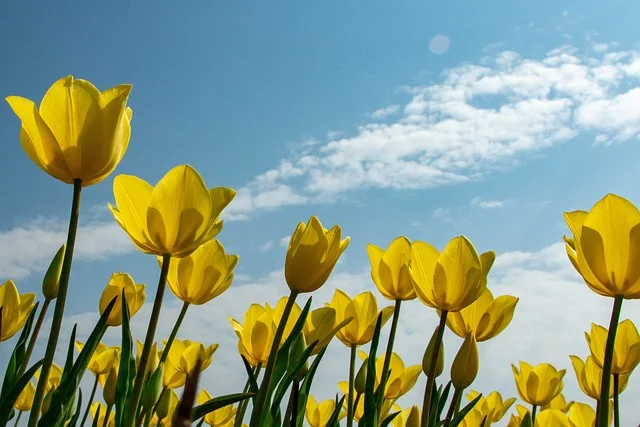Tulips (Tulipa spp.): Best Tips for Thriving Blooms in Your U.S. Garden
Table of Contents
Tulips bring vivid colors and elegant form to any garden, making them a popular choice for gardeners across the U.S. Originally from Central Asia, these blooms have a storied history and a wide range of varieties, from early bloomers to those that extend the spring color show. Here’s how to cultivate stunning tulips that will reward you with a breathtaking display year after year.

Choosing the Right Tulip Variety
When selecting tulip varieties, consider both bloom time and hardiness. Tulips are generally divided into early, mid, and late-season bloomers, allowing you to extend your garden’s color over several weeks. Here are some popular options:

- Single Early Tulips – Ideal for early spring color, these tulips bloom in March or April.
- Triumph Tulips – Known for their classic tulip shape and sturdiness, perfect for mid-spring.
- Parrot Tulips – For unique, fringed petals, look to these eye-catching tulips that bloom later in the season.
Planting Tulips for Best Results
Tulips thrive in USDA hardiness zones 3–7, but with special care, they can grow in zones outside this range.
- Timing: Plant tulip bulbs in the fall, ideally 6-8 weeks before the ground freezes. This gives them time to take root before winter.
- Location: Choose a site that receives full sun for at least six hours a day. Tulips perform best in well-draining soil to prevent bulb rot.
- Depth and Spacing: Plant bulbs 6-8 inches deep, spaced 4-6 inches apart. The rule of thumb is to plant bulbs three times as deep as they are tall.
Soil Preparation and Fertilization
Tulips prefer neutral to slightly acidic soil (pH 6.0–7.0) with good drainage. Improve soil texture by mixing in compost or sand. Before planting, add a slow-release, low-nitrogen fertilizer to promote root growth, then apply a balanced fertilizer in early spring as shoots appear.

Tulip Care and Maintenance
- Watering: Tulips require minimal watering, but be sure to water them after planting and during dry spells in early spring.
- Mulching: Adding a light layer of mulch helps regulate soil temperature and retains moisture, particularly in colder zones.
- Deadheading: Once blooms fade, deadhead the flowers to divert energy back to the bulb. Allow foliage to die back naturally to nourish the bulb for next year’s bloom.
Tips for Perennializing Tulips
While many tulips are grown as annuals, some varieties can naturalize and return each spring. Species tulips, such as Tulipa clusiana or Tulipa tarda, are more likely to perennialize. To encourage repeat blooms, plant these types in a well-drained, sunny spot and avoid over-fertilizing.

Common Issues and Pests
Tulips are susceptible to pests like voles, squirrels, and aphids. To deter rodents, consider planting bulbs with a sprinkle of crushed gravel or cayenne pepper. Tulip fire, a fungal disease, can also be an issue; avoid overwatering and ensure good air circulation around plants.
Design Ideas for Tulips in the Garden
Tulips make a striking impact when planted in large drifts or mixed with other spring bulbs like daffodils. For a natural look, scatter bulbs randomly in garden beds. In containers, combine tulips with early bloomers like pansies or violas for a continuous color display.

Conclusion
Tulips are a spring garden favorite that, with a bit of planning and care, can become a reliable, colorful fixture in your garden. By choosing the right varieties and giving them the right conditions, you can enjoy these elegant blooms as they welcome in the warmer months.
This approach provides readers with practical tips for each stage of growing tulips, from selection to care, helping them achieve beautiful, long-lasting blooms in their gardens.

Leave a Reply